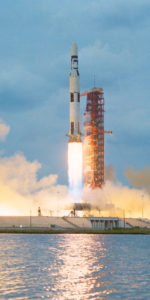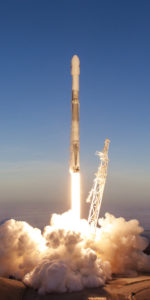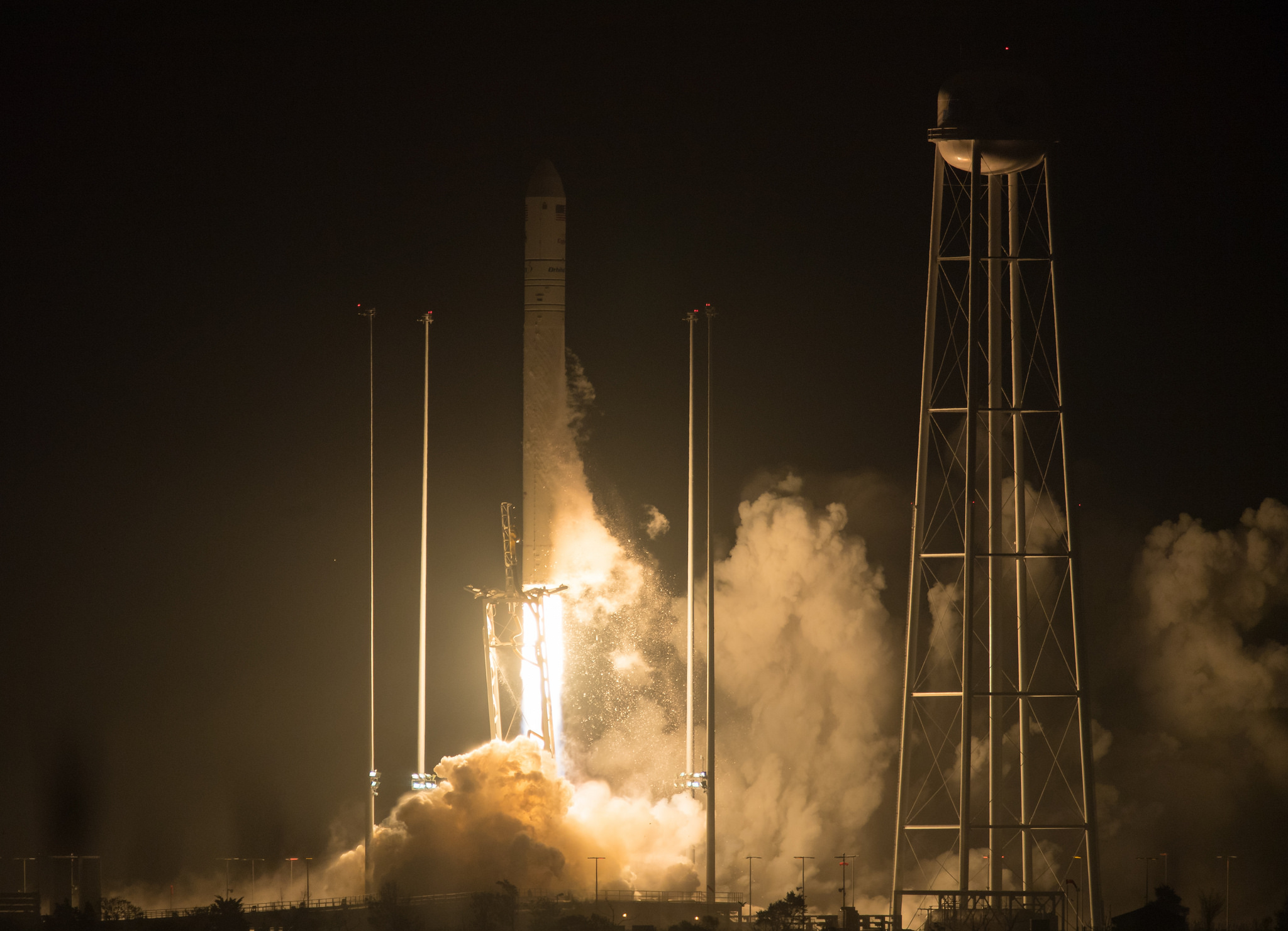
Orbital ATK’s tenth Cygnus cargo ship successfully roared away from Pad 0A at the Mid-Atlantic Regional Spaceport (MARS) on Wallops Island, Va., at 4:44 a.m. EDT Monday, 21 May. Designated “OA-9”, it was the tenth overall launch of a Cygnus, when one includes its ORB-D “demonstration” mission, back in September 2013. However, confusing the picture still further, the loss of one mission in October 2014 makes OA-9 the ninth time that one of these heavyweight cargo ships has successfully reached space. Within minutes, the liquid-fueled Antares 230 booster successfully boosted OA-9 and its 7,400 pounds (3,350 kg) of cargo, payloads and supplies for the International Space Station (ISS), where it is due to arrive on Thursday, 24 May.
“Watching an Antares launch cargo to the International Space Station is always impressive,” said Scott Lehr, President of Orbital ATK’s Flight Systems Group. “The team works very hard to ensure each NASA commercial resupply mission is successful.”
Named in honor of former NASA Deputy Administrator and senior Orbital executive James “J.R.” Thompson, who died last year, the mission is delivering hardware to support research investigations in quantum physics, advanced genetic sequencing of micro-organisms and liquid-liquid separation, together with a group of deployable CubeSats for Earth science, laser communications and astrophysics.
OA-9’s payloads are many and varied in their research scope, emphasizing quantum physics, advanced genetic sequencing of micro-organisms. The Cold Atom Laboratory (CAL) is a multi-user facility to achieve—via laser cooling—and observe ultra-cold quantum gases, as part of efforts to understand atom wave functions and develop future sensors for gravitational and magnetic fields, quantum computers and atomic clocks for spacecraft navigation. The CAL will achieve temperatures ten billion times cooler than the vacuum of space, slowing down atoms with lasers and magnetic forces until they are almost motionless, and examining them for far longer than is possible on Earth. Typically, CAL operations will be conducted during crew sleep, to minimize the potential of microgravity disturbances.
The International Commercial Experiment, nicknamed “ICE Cubes”, will be housed inside the Columbus lab and permit the running of experiments for up to four months at a time. The ICE Cubes units are small, modular containers, about the same size as a microwave oven, which can be easily slotted into payload racks aboard the lab. The Biomolecule Extraction and Sequencing Technology (BEST) investigation will permit the identification and sequencing of unknown microbial organisms aboard the ISS, using a swabs-to-sequencer methodology that eliminates the need for cultivation ahead of processing. And the Continuous Liquid-Liquid Separation in Microgravity experiment will employ surface forces to accomplish liquid-liquid extraction, a process which may find terrestrial benefits to achieve flow-rates suitable for chemical production.
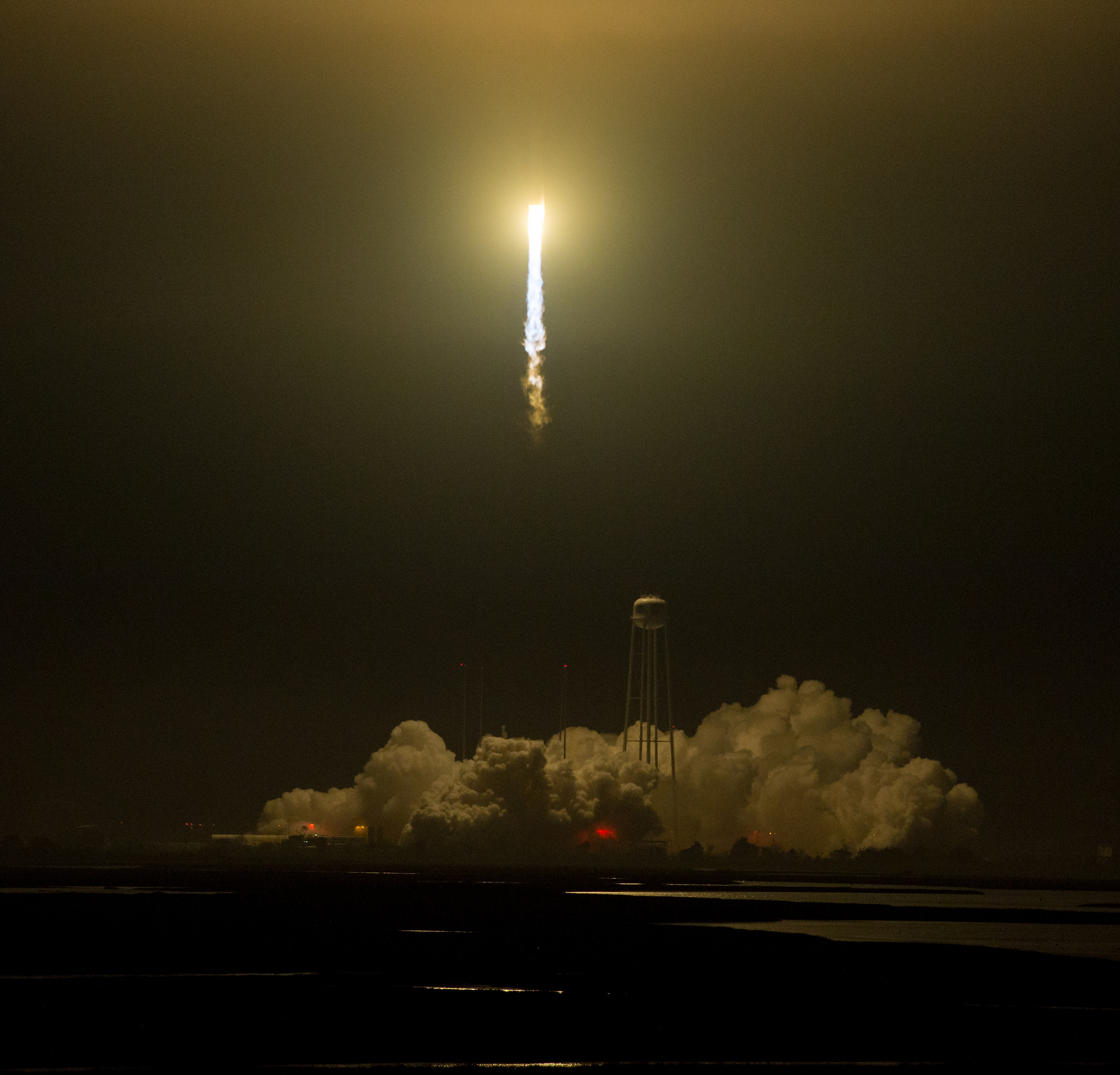
OA-9 will also transport a group of CubeSats uphill in support of Earth science, laser communications and astrophysics research. The Temporal Experiment for Storms and Tropical Systems-Demonstration (TEMPEST-D) will conduct radiometric measurements of global cloud and precipitation processes, as part of efforts to better understand Earth’s water cycle. Another experiment, Radix, seeks to demonstrate technologies for the first commercial optical data-relay system. Likened to NASA’s Tracking and Data Relay Satellite System (TDRSS), “but faster, updated, more flexible and available to commercial clients”, Radix technology is expected to greatly enhance Earth observation and monitoring science for various providers, as well as increasing mission payload utilities. Another CubeSat, dubbed “HaloSat”, wil examine the hot galactic halo of X-rays from oxygen atoms surrounding our Milky Way Galaxy to determine matter quantities.
Today’s mission is the sixth outing of Orbital ATK’s “Enhanced” Cygnus, which benefits from a “stretched” Pressurized Cargo Module (PCM) and can transport a 60-percent greater haul of payloads than its predecessor, the Standard Cygnus. Additionally, Cygnus will fly for the first time with an upgraded communications system known as Common Communication for Visiting Vehicles (C2V2). This new system provides Cygnus with the capability for enhanced communication with science payloads and improved interface with hosted payloads on future missions.
Over the weekend of 28/29 April, the spacecraft—which standards 15.9 feet (4.86 meters) tall and 10.1 feet (3.07 meters) in diameter—was loaded into the Cygnus Vertical Container (CVC) and moved to the V-55 Fueling Hall at Wallops. On 11 May, it was mated to its Antares launch vehicle in a horizontal configuration, with final “late-loading” of payload completed on the 16th.
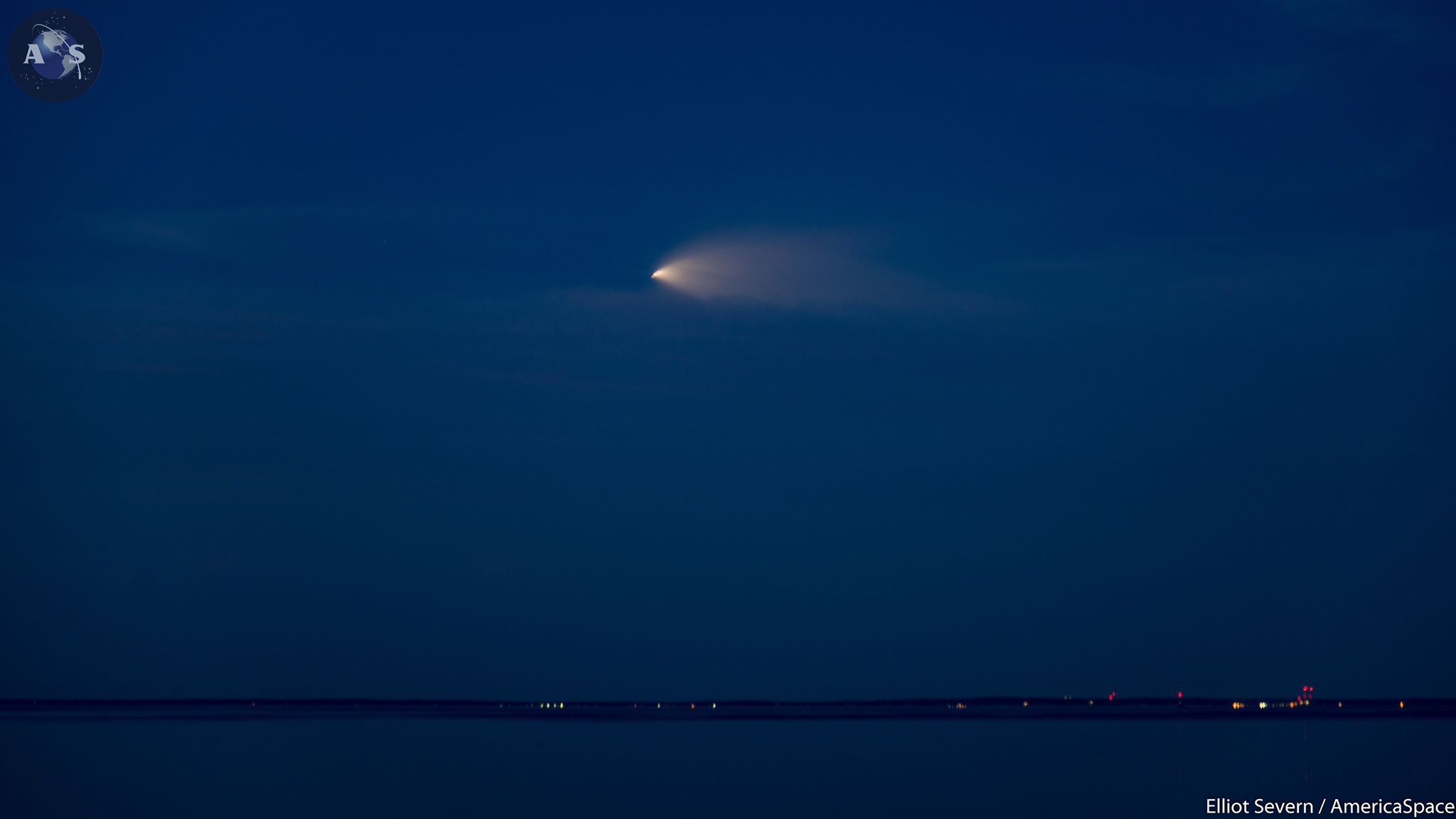
In readiness for launch, the 133-foot-tall (40.5-meter) Antares 230 booster was rolled out to Pad 0A on Thursday, 17 May, despite rain over the Delmarva Peninsula. However, by Friday afternoon a decision had been made to postpone the launch by 24 hours from Sunday morning until Monday morning. “In conjunction with NASA, we have moved the #OA9 launch to NET Monday 21 May at 4:39 a.m. EDT,” Orbital ATK tweeted Friday, “to support further pre-launch inspections and more favorable weather conditions.”
“The main weather concern for Monday’s launch attempt is sky screen,” NASA noted in a Saturday update, paying reference to local visibility conditions. “A weak cold front looks to drop into the region late Sunday afternoon, providing a chance for scattered showers and thunderstorms through that evening. Shower chances diminish by early Monday, but a weak upper-level impulse drops over the Eastern Shore during the overnight hours Sunday into Monday, providing increased cloud cover and a slight chance for an isolated shower leading up to the projected launch.”
As Orbital ATK’s first large, home-grown liquid-fueled launch vehicle, Antares is fed with a combination of liquid oxygen and a highly refined form of rocket-grade kerosene, known as “RP-1”. In the small hours of Monday morning, engineers and flight controllers came to their consoles at Wallops to begin powering up the vehicle and chilling its propellant systems with liquid nitrogen. Tanking was critically timed about 90 minutes before T-0, due to temporal limits associated with the rapid boiling-off of the cryogens, with a final poll of flight controllers conducted in two phases. By T-15 minutes, all of Antares’ propellant tanks had attained flight pressure been verified at “Flight Ready” levels. Shortly afterwards, the booster transitioned to internal power and at T-11 minutes the Transporter-Erector-Launcher (TEL) was armed to permit rapid retraction at T-0.
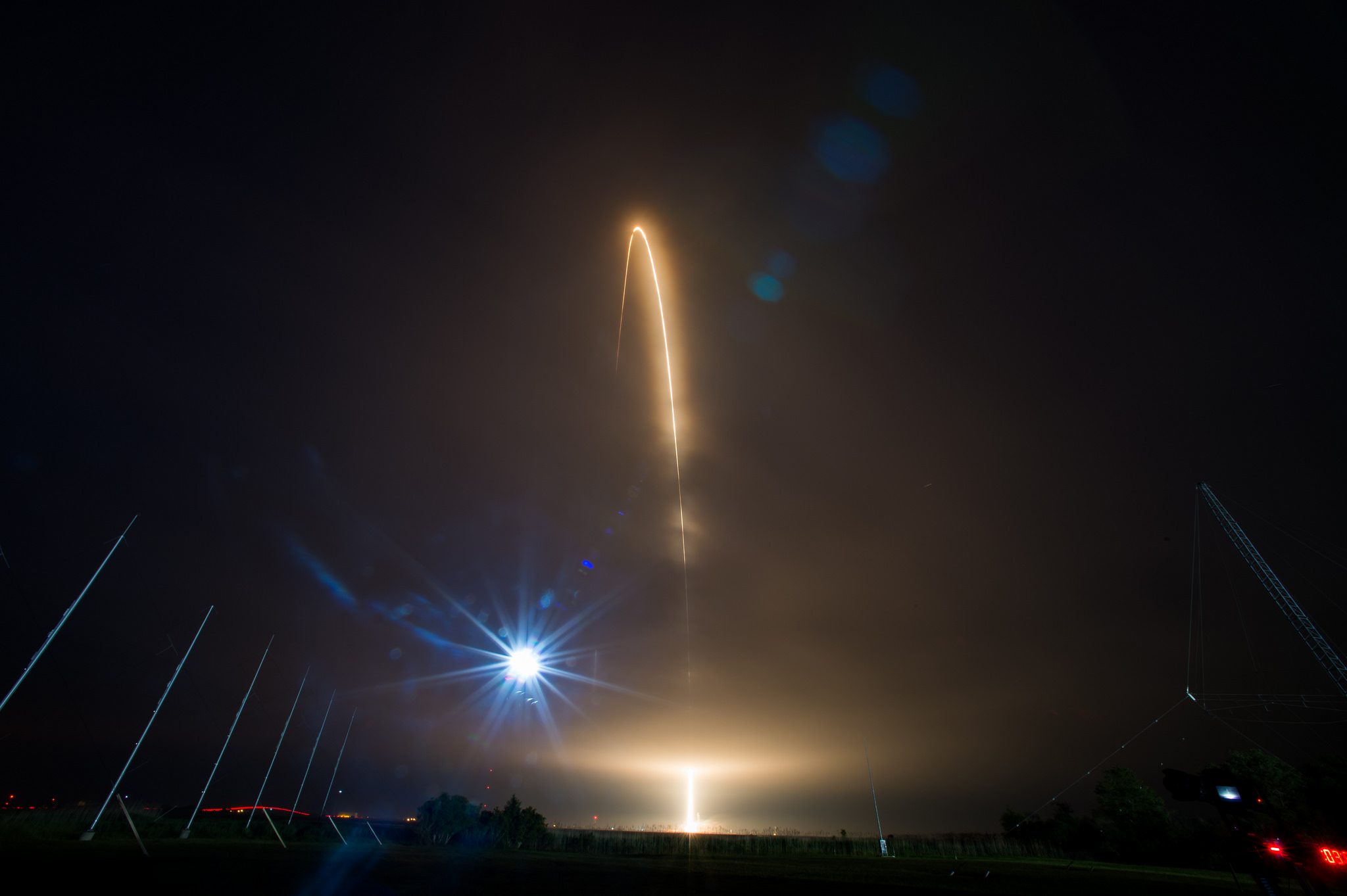
Tracking a narrow, five-minute “window” from 4:39 a.m. through 4:44 a.m., the closing part of the countdown carry particular criticality. The rocket’s autosequencer assumed primary control at T-3 minutes and 30 seconds, commanding all events through liftoff, and the OA-9 spacecraft was placed on internal power. It would run on its internal batteries until such time as its fan-shaped solar arrays were deployed in orbit.
The twin RD-181 engines at the base of the first stage roared to life, ramping up to a combined thrust of 937,000 pounds (425,000 kg). The booster cleared the Pad 0A tower and rose glowingly into the pre-dawn Virginia skies, commencing a pitch and roll program maneuver to establish itself onto the proper flight azimuth to achieve orbit. Maximum aerodynamic pressures on the vehicle were attained at T+80 seconds. All told, the RD-181 engines burned hot and hard for 3.5 minutes, burning almost 530,000 pounds (240,000 kg) of propellants, before shutting down. Next, the first stage was discarded and the solid-fueled Castor-XL upper stage ignited to position Cygnus in an orbital “slot” about 220 miles (350 km) above Earth.
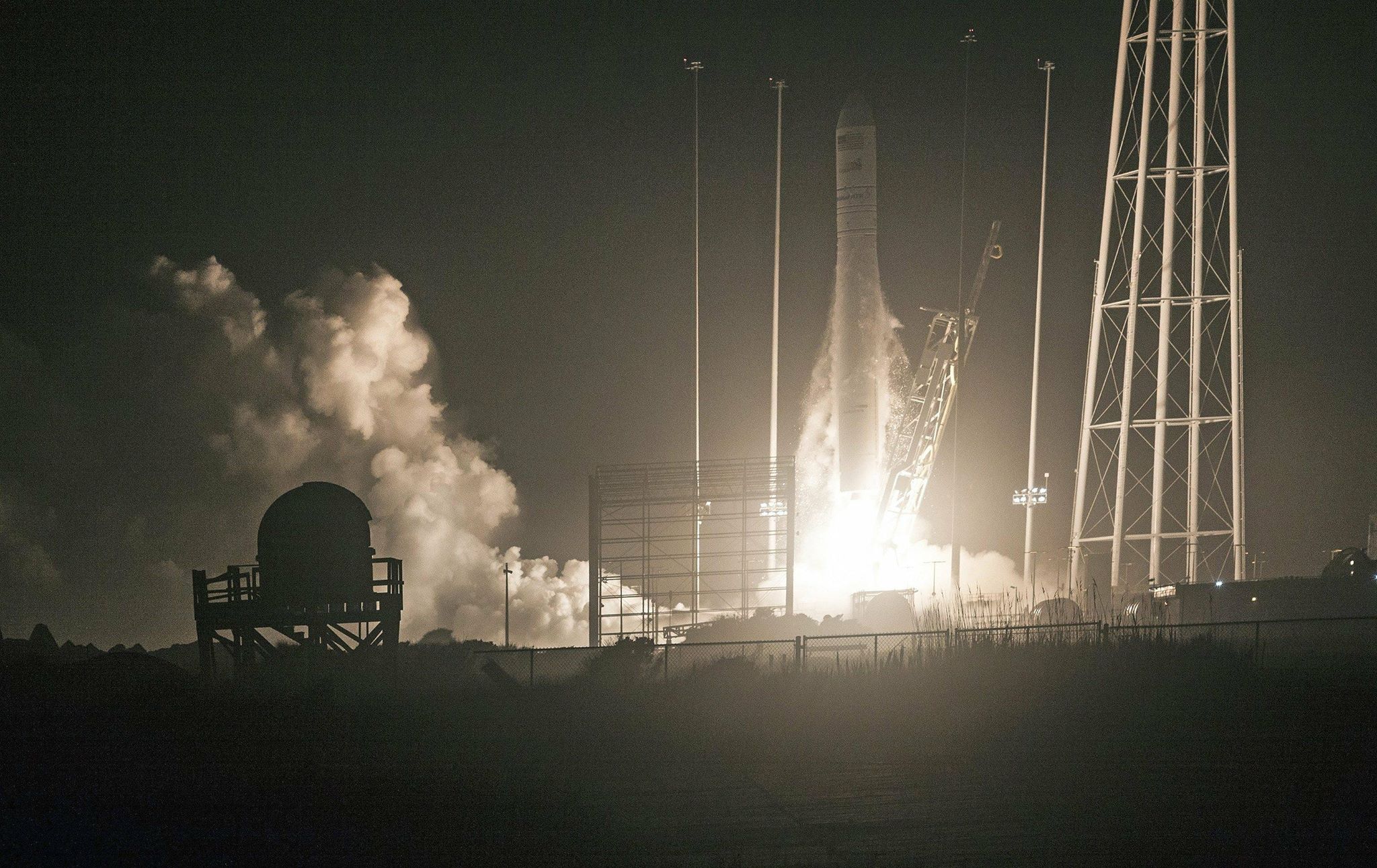
“Orbital ATK is proud to once again support the crew on the International Space Station by delivering valuable supplies, equipment and science,” said Frank Culbertson, President of Orbital ATK’s Space Systems Group. “The upgraded avionics and communication system on the spacecraft demonstrate our commitment to increasing the flexibility and versatility of Cygnus to carry a wide range of payloads. We are also honored to name this mission after J.R. Thompson, a pioneer in the space industry and someone who many of us here at Orbital ATK and in the NASA community were honored to call a colleague and friend.”
Current plans envisage a berthing at the ISS on Thursday, 24 May. Capture and berthing operations will be overseen by Expedition 55 Flight Engineer Scott “Maker” Tingle and OA-9 will remain attached to the station for around two months. Unberthing and departure is tentatively scheduled for 15 July, after which Cygnus—laden with trash and unneeded equipment—will be directed onto a destructive dive to burn up in the atmosphere.
FOLLOW AmericaSpace on Facebook!
.
Missions » ISS » COTS » CYGNUS »



